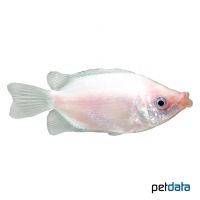Golden Kissing Gourami (Helostoma temminckii 'Gold')
| Golden Kissing Gourami Helostoma temminckii 'Gold' | |
|---|---|
| Name | Golden Kissing Gourami |
| Name Lat. | Helostoma temminckii 'Gold' |
| Family | Kissing Gouramies |
| Family lat. | Helostomatidae |
| Order | Labyrinth Fishes |
| Order lat. | Anabantiformes |
| Origin | Southeast Asia |
| Habitat | Streams, rivers |
| Diet | Omnivore |
| pH | 6.0-8.0 |
| Behavior | ♂ territorial |
| Keeping | Pair |
| Care Level | Experts only |
| Reproduction | Egg scatterer |
| Breeding | Moderately difficult |
| Life Span | 4-6 years |
| Protection | No |
| Metric Units | |
| Size | 20-25 cm |
| Temperature | 24-30 °C |
| Hardness | 1-20 °dH |
| Aquarium | ~ 350 l |
| US Units | |
| Size | 8"-10" |
| Temperature | 75-86 °F |
| Hardness | 18-356 ppm |
| Aquarium | ~ 90 gal |
Distribution and habitat
Originally from the island of Java, kissing gourami are now distributed across the Greater Sunda Islands to Borneo and throughout most of southern Indochina, including the Malay Peninsula. They live in slow-moving or stagnant waters with dense vegetation.
Maintenance
The aquarium should have a dense planting with partly large-leaved plants and offer hiding places (roots) and sufficient swimming space. A dark substrate with foliage (sea almond leaves) and some subdued light (floating plants) is ideal.
No ammonia, ammonium or nitrite should be detectable, the nitrate value should not exceed 100 mg/l. To ensure the water quality and oxygen content, a filter and heater adapted to the aquarium size is required, as well as lighting for the species-appropriate day-night rhythm of the animals.
Diet
They are filter feeders with a specialized gill trap apparatus and feed mainly on very fine plankton, suck tiny organisms from algae growth with their extendable lips and rasp on plant leaves. For a balanced diet, feed once daily with a high-quality dry food (flakes, granules, pellets) as well as plankton food and Artemia nauplii, Cyclops or Daphnia (live or frozen). In addition, they need regular plant food, such as over-broiled lettuce leaves, algae leaves or dry food with plant ingredients (e.g. spirulina)
Only feed as much as will be eaten within a few minutes. A regular and varied diet promotes health and prevents deficiency symptoms.
Behaviour and compatibility
They should be kept in pairs and do well in a community tank with other hardy fish. Adult males often behave territorially. Ritualized mouthing (kissing) is seen as a characteristic behavior with rival males, but also during mating
Basically, only mutually compatible fish species with similar demands on water condition and water temperature should be socialized.
Sex dimorphism
The sexes are difficult to distinguish, only with the onset of spawning the female becomes recognizable by the fullness of her body.
Reproduction and breeding
They are free spawners and do not engage in brood care. The eggs, several thousand of them, which are ejected during the revolving loops, rise to the water surface and adhere to plant leaves and stems with their sticky shell. The larvae hatch after about 24 hours and continue to feed on their yolk supply for several days before ingesting fine food for the first time.
The fry must be fed several times a day with special rearing food (dust food, Artemia nauplii). In a community tank breeding is hardly possible, because the fry are easy prey.
Important
They have an additional respiratory organ called the labyrinth (suprabranchial organ) with which they breathe atmospheric air and can suffocate if this is not possible
They require a lot of warmth, the water temperature should be at least 24 °C.
The well-being of the fish should be checked regularly. Temperature should be checked daily, pH, hardness and nitrate levels at least every 14 days. A regular partial water change is recommended, even if the pollutant load has not yet reached the upper limit. Sudden changes in water quality should be avoided. Newly introduced fish must be accustomed slowly to the water in the aquarium
Further literature can be found in your pet store.
References
Text: petdata; Image: petdata
Source: BMEL (1998): Tierschutzgutachten - Haltung von Zierfischen (Süßwasser); RIEHL & BAENSCH (2006): Aquarien Atlas Bd. 1, Mergus Verlag; ENGELMANN (2005): Zootierhaltung - Tiere in menschlicher Obhut: Fische, Verlag Harri Deutsch
- Gemäß § 21 Abs. 5 Tierschutzgesetz idgF
